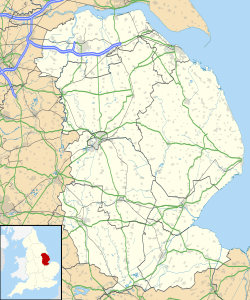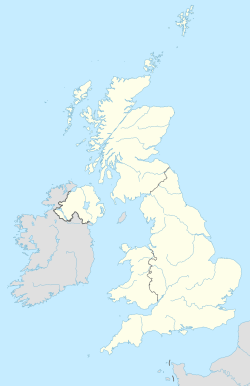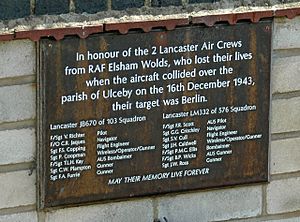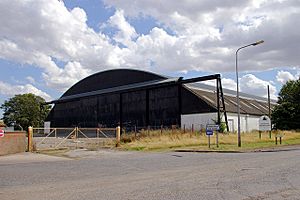RAF Elsham Wolds facts for kids
Quick facts for kids RAF Elsham Wolds
|
|||||||||||
|---|---|---|---|---|---|---|---|---|---|---|---|
| Elsham, Lincolnshire in England | |||||||||||
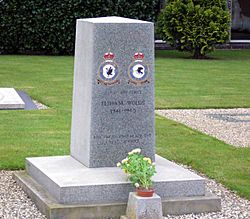
Memorial dedicated to those lost on operations
|
|||||||||||
|
Shown within Lincolnshire
|
|||||||||||
| Coordinates | 53°36′23″N 000°25′19″W / 53.60639°N 0.42194°W | ||||||||||
| Type | Parent station 1941-43 13 Base 1943-47 |
||||||||||
| Code | ES | ||||||||||
| Site information | |||||||||||
| Owner | Air Ministry | ||||||||||
| Operator | Royal Air Force | ||||||||||
| Controlled by | RAF Bomber Command * No. 1 Group RAF |
||||||||||
| Site history | |||||||||||
| Built | 1916 | ||||||||||
| In use | 1916-1919 July 1941-1947 |
||||||||||
| Battles/wars | European theatre of World War II | ||||||||||
| Airfield information | |||||||||||
| Elevation | 73 metres (240 ft) AMSL | ||||||||||
|
|||||||||||
Royal Air Force Elsham Wolds, or RAF Elsham Wolds, was a special place in England. It was an air base that helped protect the country during both the First World War and the Second World War. You can find it near the village of Elsham in northern Lincolnshire.
Contents
RAF Elsham Wolds in World War I
An airfield was first built at Elsham in December 1916. It was used by a part of No. 33 Squadron of the Royal Flying Corps. They flew F.E.2, Avro 504, and Bristol F.2 Fighter planes. From June 1918 to June 1919, this base was also the squadron's main office.
Elsham was the most northern of three airfields. The others were at RAF Kirton in Lindsey and RAF Scampton. These bases were placed to help stop Zeppelin airships from attacking at night. The planes from Elsham also helped the artillery guns at Spurn Head and Kilnsea.
The flight stayed at Elsham until June 1918. After the First World War ended in 1919, the wooden buildings and aircraft shed were taken down. The land then went back to being used for farming.
RAF Elsham Wolds in World War II
In the late 1930s, another war was coming. More airfields were needed for the growing Royal Air Force. Experts looked at old First World War bases to see if they could be used again. An area west of the first Elsham site was chosen as a better spot.
Work started in the winter of 1939–1940. The new base opened in July 1941 when 103 Squadron arrived. The station had one main runway that was about 1,829 meters long. It also had two shorter runways.
Three large hangars were built, along with 27 parking spots for aircraft. Later, more parking spots were added, making a total of 36. Three more hangars were built in 1944. About 2,500 people lived and worked at the base. Their homes were spread out in the nearby fields.
No. 103 Squadron flew more missions than any other squadron in its group. Because of this, they also had the most losses. Out of 248 bombers lost from Elsham Wolds, 198 were from No. 103 Squadron. The planes lost included 28 Vickers Wellingtons, 12 Halifaxes, and 208 Lancasters.
One special Lancaster plane from Elsham Wolds, named "Mike Squared" (ED888), flew 140 missions. This was a record for RAF Bomber Command. It flew for 974 hours between May 1943 and December 1944.
An Australian navigator named Don Charlwood flew from Elsham Wolds. In his book, he wrote about the brave aircrews. He shared how many of his friends did not return from their missions. He said that out of 20 young men who arrived with him, only eight were still there a few months later.
After the War: What Happened Next?
RAF Elsham Wolds closed in 1947. After the war, many people from Poland and Ukraine who had been displaced by the war lived there for a short time. They worked at the Scunthorpe Steelworks. Some hoped to move to the US or Canada, while others decided to stay in places like Scunthorpe.
People sometimes called the site "Warsaw Hamlet" because so many Polish people lived there. The Post Office even delivered mail to that address. By 1952 or 1953, these people had moved on. The land then went back to farming and later became an industrial area.
Some of the road names in the industrial area remember the base's history. These include Halifax Approach and Wellington Way, named after the famous planes. In the 1970s, the A15 road was built right through the site. This road connects the M180 motorway to the Humber Bridge. The old control tower was used as a house for a while in the 1980s. People even said it was haunted! One of the original J-Type hangars is still standing today.
What is Elsham Wolds Like Today?
Today, a very tall radio and telephone mast stands on top of Elsham hill. This tower is at the west end of what used to be the main runway. In the 1960s, it helped send radar signals from other RAF stations.
There is also a special memorial garden. You can find it in the southwestern part of the old airfield. It helps people remember those who served there.
Images for kids


